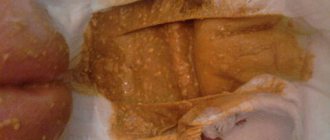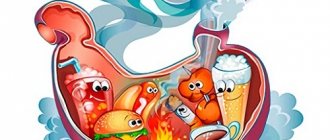Home > Baby > Newborn health >
Young parents, due to their inexperience, are sometimes too sensitive to their child. They worry when the baby sleeps and when he is awake, eats well or refuses to eat, goes to the toilet often or rarely. Everything seems to them to be a deviation from the norm. Therefore, upon discovering white lumps in a baby’s stool, worried mothers and fathers rush to the doctor.
- 1 The norm is individual
- 2 Separately about white formations
- 3 More about enzyme deficiency
Causes of white stool
Light-colored stool or white streaks in the stool often indicate a cessation of bilirubin flow into the intestines. It is bilirubin that is synthesized in the intestines into stercobilin, a special pigment substance that gives feces its characteristic brown color.
White lumps in the stool of an infant or light-colored stool in an adult occur due to dietary habits or consumption of certain foods. If an adult has white grains in their stool after drinking milk, this indicates a high fat content of the milk. For the same reason, light lumps appear in the baby's stool, but in this case we are talking about breast milk.
Often, white lumps in stool appear after eating butter, kefir, sour cream or lard. In such situations, it is enough to adjust your diet so that the white coating on the stool no longer appears.
Important! There is a connection between light-colored stools and alcohol, since this toxic product has a negative effect on the liver.
Light inclusions in stool may appear due to the use of certain medications:
The structure of human lice: types and symptoms of infection
- antifungal drugs;
- antibiotics;
- oral contraceptives;
- medicines to treat gout;
- medicinal anti-tuberculosis drugs;
- antiepileptic drugs;
- medications containing acetylsalicylic acid;
- NSAIDs – non-steroidal anti-inflammatory drugs;
- some rectal suppositories;
- with an overdose of paracetamol;
- Smecta;
- Tramadol.
Usually, after you stop taking medications that cause changes in the color of your stool, the white spots in your stool should disappear. If this does not happen, you should consult a specialist.
White lumps in stool may appear due to the following conditions:
- Light particles and strings in a woman’s feces can be detected both during pregnancy and immediately after childbirth. This is usually due to dietary habits or pathologies of the liver and gastrointestinal tract.
- Light-colored lumps in a baby's stool are not a cause for concern; they usually indicate immaturity of the gastrointestinal tract.
- White grains in the stool of an adult and generally light-colored stools occur after surgical removal of the gallbladder.
- This shade of feces may appear after an X-ray examination with contrast in the form of barium sulfate.
- After poisoning, white feces may also appear.
- Light-colored feces may indicate excess carbohydrate intake in the human body.
In a newborn and infant, white curdled grains and flakes in the feces do not indicate any disease. Such stools may be due to formula milk, complementary dairy products, or the characteristics of mother's milk. The stool of a baby under one year old who is exclusively breastfed can be of any color.
Something white in an adult's stool should alert you. This is a reason to contact a medical facility or review your diet. In old age, white feces are definitely a sign of a serious illness.
Baby is constipated. How to identify?
Despite the widespread opinion of some pediatricians that a child can rarely have bowel movements, sometimes he has to wait up to seven days, and if this does not bother him, then mom and dad have nothing to worry about, not all doctors support this theory. A bowel movement that occurs less frequently than once every two to three days already becomes constipation. Normally, a baby fed on breast milk should soil a diaper 5-6 times a day in the first months of his life. Those who eat an adapted milk formula have stools less often – up to 4 times.
Associated symptoms of light stools
What is a dwarf tapeworm: the structure and life cycle of the parasite
Often, white spots in feces do not appear independently, but accompanied by some accompanying symptoms that will help to understand the reason for this color of feces and identify pathology. So, you should pay attention to the following symptoms:
- Whitish worms in the stool indicate a parasitic disease. These could be roundworms, pinworms or cat flukes. In this case, it is necessary to deworm the body, since many parasites cause dangerous complications.
- Various light lumps and dots in the stool indicate the removal of undigested food debris from the intestines. This is usually food of plant origin. This may also be indicated by stool with thin white streaks. By themselves, such lumps and dots are not a reason to go to the doctor, but in combination with light, loose stools they indicate cholecystitis, which requires treatment from a specialist. The same can be said about stool with white fibers.
- Liquid white feces indicate a malfunction of the liver or pancreas. This usually happens with hepatitis, chronic pancreatitis, bile duct dyskinesia.
- White feces in combination with dark urine and yellowing of the skin indicate hepatitis. Contact a medical facility immediately.
- Light-colored feces in combination with pain in the area of the right hypochondrium indicate pathologies of the liver and gall bladder. In this case, the consistency of stool may be normal.
- Liquid white stools combined with high fever appear at the beginning of the inflammatory process. These symptoms, combined with vomiting in a child, are a symptom of a viral infection.
- White-coated feces and mucus in it may indirectly indicate fistulas in the intestines (proctitis). Often with this disease, whitish balls of mucus are found in the feces. An accompanying symptom may be pain during bowel movements and fever. Often, with cracks in the anus, blood appears in the stool.
- Foul-smelling white feces occur with cancer of the pancreas, liver itself, or gall bladder. With pancreatitis, this may indicate a transition of the disease to a chronic form.
- Constipation in combination with such discharge indicates a malfunction of the gallbladder and liver.
- Light foamy stools occur with enterocolitis, ulcers and other gastrointestinal pathologies.
- This symptom, combined with bloating, can be due to dysbacteriosis. In this case, the feces may take on a slightly greenish tint.
Artificial feeding is normal
With bottle-fed babies, the situation is a little different. Most often, having selected a certain mixture, the mother chooses it. This ensures consistency and stability during feeding. In addition, special recommendations have been created for the amount eaten at one time, per day, for each age and weight of the child. And it’s easy to check whether the baby has eaten everything in the bottle. It happens that a child does not eat as much as he should according to the norms, so the mother does not always follow the plans developed by pediatricians, changing the amount of food at her own discretion. This can also lead to problems in the intestines, and the newborn baby will show it in the contents of the diaper.
What ailments can light-colored feces indicate?
The presence of a large number of white grains in the stool of an adult and the white color of the stool may indicate the following pathological conditions:
- Hepatitis. With this disease, such feces are combined with yellow skin and dark urine.
- Pancreatitis. Usually the patient feels pain in the left hypochondrium. Often the cause of the disease is the abuse of fatty foods and alcohol.
- Cholecystitis. In this case, in combination with white stool, other symptoms are present: nausea, vomiting, high fever, poor appetite and pain in the stomach area.
- Oncology of the gastrointestinal tract. In the initial stages, there may be no other symptoms. In the later stages, pain occurs, appetite worsens, and weight loss is often observed.
- Crohn's disease. This is a pathology of infectious, psychosomatic or allergic origin. Usually the disease is accompanied by fever, vomiting, loss of appetite, and weight loss.
- Cirrhosis of the liver. Such feces in this disease are at the stage of decompensation or subcompensation.
Treatment
The detection of most of the mentioned impurities is the basis for contacting a gastroenterologist at the clinic. The local physician can also refer the patient to a specialized specialist and prescribe a series of tests.
Specialists whose consultation may be needed:
- proctologist;
- infectious disease specialist;
- surgeon;
- hematologist;
- oncologist.
Important: if a large amount of blood is released against the background of a deterioration in the general condition, you should call an ambulance. Massive bleeding is a life-threatening condition and requires hospitalization of the patient in the intensive care unit or intensive care unit.
Since the presence of impurities is not a disease, but only one of the symptoms, the underlying pathology is treated. If a helminthic infestation is suspected, it is important to determine the type of parasite.
To establish or clarify the diagnosis, in most cases the patient is referred for examination to an endoscopist.
Plisov Vladimir, medical observer
64, total, today
( 52 votes, average: 4.37 out of 5)
Treatment of colitis with folk remedies
Intestinal obstruction: symptoms, causes, treatment and emergency care
Related Posts
Who to contact?
If your stool is light-colored, you can contact different specialists depending on the accompanying symptoms. So, for helminthiasis, treatment is carried out by a parasitologist. If the illness is caused by an infectious disease, then you should consult a therapist or infectious disease specialist.
If light-colored feces appear against the background of pathologies of the gastrointestinal tract and digestive organs, then you need to see a gastroenterologist. If in addition to white specks, mucus and blood appear in the newborn’s stool, or the stool is too liquid, foamy and smelly, then first of all you should tell the pediatrician about this. This specialist will order additional tests and, if there is cause for concern, refer the child to a specialist.
Diagnostics
To establish an accurate diagnosis, a pediatrician or gastroenterologist may require additional studies:
- clinical or biochemical blood test;
- coprocytogram is an analysis that shows qualitative and quantitative changes in feces (neutral fats, digestible fiber, muscle fibers, iodophilic flora, etc.);
- bacteriological examination of feces for pathogenic microorganisms and their sensitivity to antibacterial drugs;
- ultrasound examination of internal organs, including the pancreas;
- genetic tests for congenital pathologies;
- radiography.
We recommend reading:
What does human feces consist of?
The range of examinations is determined by the expected diagnosis and the age of the child.
When to see a doctor
First of all, you need to determine the reason for their appearance. If the child behaves normally, then there is no need to worry too much. After two to three days, all symptoms should go away. It’s another matter if after a few days the symptoms do not go away. In this case, you need to urgently consult a doctor. Remember that an increase in white lumps may be a consequence of dysbiosis.
If the pediatrician, after you took the tests, confirmed your guess and this is indeed dysbacteriosis, then treatment should be started immediately. In most cases, certain medications are prescribed to help relieve the problem. Attention! In this case, you should not select the drug yourself. Remember that most medications intended to treat dysbiosis are not suitable for infants.
Therefore, going to the doctor is mandatory:
- It is recommended to delay the introduction of complementary foods;
- Mom must adjust her own menu if she resorts to breastfeeding. Down with fried and fatty foods, alcohol;
- It is recommended to feed the baby more often, but in a reduced volume, since the cause of the pathology may be banal overeating;
- If nausea and vomiting or diarrhea are observed, immediately call a doctor or ambulance.
The same applies to the selection of soothing herbal infusions and decoctions. Remember that you cannot know all the indications and contraindications for using a particular plant. And you still don’t have information about how your baby will tolerate this decoction, whether he has allergies. Therefore, treatment options for such diseases associated with the digestive tract should be discussed with your doctor.











